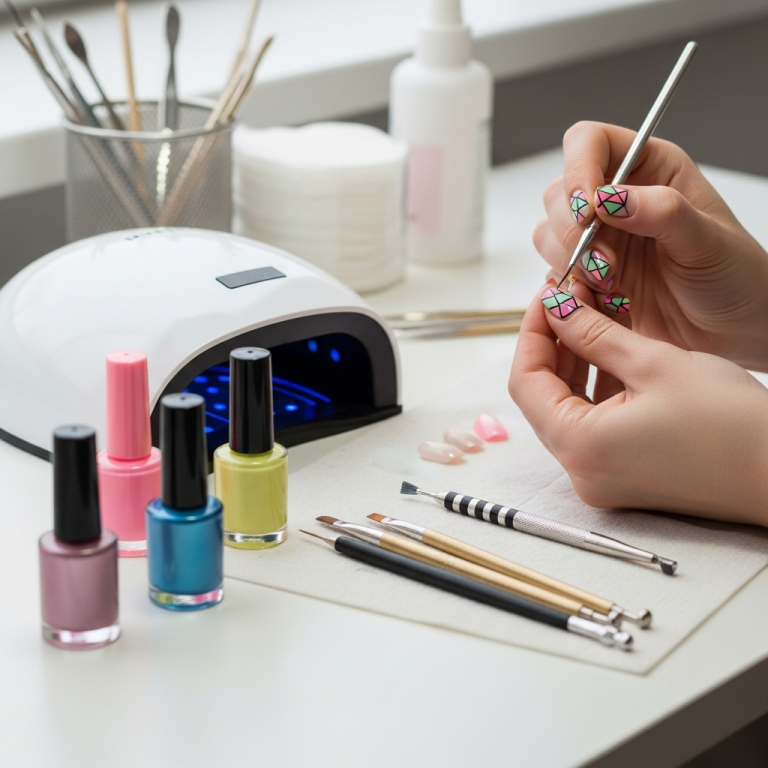Spider web nail designs are a chic and spooky way to elevate your manicure, offering a versatile and eye-catching look achievable for beginners. With simple techniques and the right tools, you can create intricate web patterns for a Halloween vibe or a subtle edgy accent any time of year.
Hey nail lovers! Have you ever wanted to try a nail design that’s a little bit spooky, a little bit chic, and totally mesmerizing? Spider web nails are just that! They look super intricate, but I promise, they are easier to create than you might think. Whether you’re getting ready for Halloween or just love a cool, edgy look, spider webs are a fantastic choice. Don’t worry if you’re new to nail art; I’m here to walk you through everything step-by-step. We’ll cover the tools you’ll need, the easiest ways to get those perfect webs, and even some fun variations to try out. Get ready to transform your nails into tiny works of art!
Why Spider Web Nail Designs Are So Popular
There’s something undeniably cool about a spider web design on your nails. It’s a classic motif, especially around spooky seasons, but it’s also evolved into a trend that can be both subtle and bold. The beauty of spider webs lies in their versatility. You can go all-out with a full web on every nail, or you can use a delicate web as an accent detail. Plus, they offer a fantastic canvas for creative color combinations. Think classic black and white, eerie greens and purples, or even vibrant neons!
Essential Tools for Your Spider Web Manicure
Before we dive into the fun part of creating the webs, let’s make sure you have the right tools. Having these on hand will make the process so much smoother and give you the best results.
Here’s a quick rundown of what you’ll need:
Base Coat: This protects your natural nails and helps your polish last longer.
Nail Polish Colors: You’ll need a base color for your nails and a contrasting color for the web design. Black, white, grey, and deep reds are popular choices.
Thin Nail Art Brush or Detailer Brush: This is crucial for drawing those fine lines. Look for one with very fine, tapered bristles.
Dotting Tools (Optional but helpful): These can be used to place small dots to start your web or add accents.
Spider Web Stencils or Stickers (Optional): For an even easier application, stencils and stickers are fantastic!
Top Coat: To seal your design and add a glossy finish.
Clean-up Brush: An angled brush with stiff bristles, dipped in nail polish remover, is perfect for cleaning up any stray lines.
Nail Polish Remover: For cleaning up mistakes.
Alcohol Wipes or Rubbing Alcohol: To ensure your nails are free of oils before you start painting.
Having a good set of nail art brushes is a game-changer for any DIY manicure. For spider webs, a brush that’s around 1/8 inch in length for the bristles is generally a good starting point for fine detail work. Just remember to keep your brushes clean after each use to ensure they last!
Method 1: The Classic Hand-Painted Spider Web
This is the most popular method and gives you a lot of control over your design. It might take a little practice, but the results are so worth it!
Step 1: Prep Your Nails
Start with clean, dry nails. Make sure to remove any old polish.
Shape your nails to your desired length and shape using a nail file.
Apply a thin layer of your chosen base coat and let it dry completely. This is super important to prevent staining and make your polish adhere better.
Step 2: Apply Your Base Color
Apply one or two coats of your main nail polish color. Let each coat dry thoroughly. A good base color is essential for making your web design pop!
Step 3: Draw the Initial Lines
Dip your thin nail art brush into your web color polish. You want just enough polish on the brush to draw a line, not too much that it’s gloopy.
Starting from the center of your nail (or just off-center, depending on your design), draw a few straight lines radiating outwards towards the edges of your nail. Think of it like drawing spokes on a wheel. You can have as many or as few as you like! For a classic look, 3-5 lines are usually perfect.
Don’t worry if they aren’t perfectly straight – a little wobble adds character!
Step 4: Connect the Lines
Now, dip your brush again if needed.
Go back to one of the central lines.
Draw a small, curved line connecting the central line to the adjacent radiating line.
Move along that same radiating line and draw another curved line connecting it to the next radiating line.
Continue this process, working your way outwards, connecting each radiating line with small, curved dashes.
Repeat this for all your radiating lines until you have a complete web pattern.
Pro Tip: If you find drawing the connecting lines tricky, try using a dotting tool to place a tiny dot on each radiating line where you want your connecting line to go. Then, connect the dots with your brush!
Step 5: Refine and Add Details (Optional)
Once the main web is drawn, you can go back with your thin brush to thicken any lines that look too faint or add extra little details.
You could add a tiny dot or two in the center or at the intersections for extra dimension.
If you want to add a small spider, draw a tiny oval for the body and tiny lines for legs.
Step 6: Clean Up Your Edges
Dip your clean-up brush into nail polish remover.
Carefully trace around the edges of your nail, cleaning up any polish that got onto your skin. This step makes a huge difference in how professional your manicure looks!
Step 7: Apply Top Coat
Once all the nail art is completely dry, apply a generous layer of top coat. This seals the design, adds shine, and helps your manicure last much longer. Make sure to cap the free edge of your nail too!
Method 2: The Cobweb Effect with Gel Polish
Gel polish offers a slightly different experience, and some people find it easier to manipulate for intricate designs. The slightly thicker consistency of gel can be forgiving.
Step 1: Prep and Base Gel
Prep your nails as usual (shape, buff, cleanse).
Apply a base coat (gel or regular, depending on your system) and cure under a UV/LED lamp.
Step 2: Apply Color Gel
Apply your main color gel polish and cure. Apply a second coat if needed and cure again.
Step 3: Create the Web using Spider Gel or Thick Gel Polish
There are special “spider gels” or “web gels” available that are designed to be pulled into thin, stringy lines. These are usually very pigmented and sticky.
Alternatively, you can use a very thick, non-wipe gel top coat. Apply a thin layer of the non-wipe top coat to your cured color.
Using your thin detailer brush (or the applicator that comes with spider gel), pick up a bit of the spider gel or the thick gel.
Start by drawing a few radiating lines from the center of your nail outwards, similar to Method 1.
Then, carefully pull thin, stringy lines between these main lines to create the web. Spider gels are designed to stretch for this purpose.
If using a regular thick gel polish, be more gentle when connecting the lines.
If you used a gel top coat beneath the web design, you’ll need to cure the web design itself. If you used a specific spider gel, follow its curing instructions.
Step 4: Cure and Top Coat
Cure your spider web design under your UV/LED lamp according to the gel product’s instructions.
Apply a final top coat (gel or regular), making sure it’s compatible with your gel system, and cure if necessary. For gel systems, a non-wipe top coat is often preferred for a lasting shine.
Method 3: Using Stencils and Stickers
If hand-painting feels a bit daunting, these methods are perfect for beginners!
Using Nail Stencils
1. Prep and Polish: Prepare your nails and apply your base color as usual. Ensure the polish is completely dry.
2. Apply Stencil: Carefully place a spider web stencil onto your nail. Ensure it lies flat with no air bubbles. You can buy reusable vinyl stencils or disposable paper ones.
3. Paint Over: Using your detailer brush or a fine-tipped brush, carefully paint over the stencil openings with your web color. Work methodically to fill the design.
4. Remove Stencil: While the polish is still wet, very carefully peel away the stencil using tweezers. The goal is to lift it off cleanly, leaving the web design behind. This requires a gentle touch.
5. Let Dry and Top Coat: Allow the design to dry completely before applying your top coat.
Using Nail Stickers/Decals
1. Prep and Polish: Prepare your nails and apply your base color. Let it dry completely.
2. Apply Sticker: Gently peel a spider web sticker or decal from its backing.
3. Place on Nail: Carefully position the sticker onto your nail. Press down firmly, especially around the edges, to ensure it sticks well and to avoid lifting.
4. Seal with Top Coat: Apply a good quality top coat over the sticker. Make sure to fully cover the sticker to prevent it from peeling up later.
Nail stickers and stencils are a fantastic way to achieve intricate designs with minimal effort. Brands like Born Pretty and Amazon offer a wide variety of these. For best results with stickers, a good quality top coat is your best friend to secure them.
Styling Your Spider Web Nails: Beyond the Basics
Once you’ve mastered the basic web, you can have so much fun with variations!
Color Combinations
Classic Spooky: Black webs on a white or grey base.
Metallic Magic: Silver or gold webs on a deep jewel tone like emerald, sapphire, or ruby.
Glow-in-the-Dark: Use glow-in-the-dark polish for the web on a black base for a surprise reveal!
Neon Pop: Bright neon webs on a dark base for a bold, edgy look.
Matte Finish: Apply a matte top coat over a glossy web design for a sophisticated contrast.
Placement and Accent Nails
Single Accent Nail: Apply a full web design on just one or two nails (like your ring finger) and keep the others a solid color.
Partial Webs: Draw just a portion of a web on a corner or side of the nail.
Web Accents on French Tips: Draw a small web in the corner of your French tip or along the smile line.
Webbed Dots: Instead of a full web, just create a few connected dots that resemble a small web.
Adding Other Elements
Tiny Spiders: As mentioned, add a small hand-painted spider!
Gems and Studs: Place a small black or clear gem in the center of the web or where the lines intersect.
Glitter: Sprinkle a little fine glitter onto wet polish in the web for some sparkle.
Layering: Paint a solid color, then a web, then perhaps a sheer color over the top for depth.
Maintaining Your Spider Web Nails
To keep your stunning spider web nails looking their best, a little care goes a long way:
Wear Gloves: Always wear gloves when doing chores, washing dishes, or using cleaning products. This protects your polish from harsh chemicals and prevents chipping.
Moisturize: Keep your cuticles and hands hydrated with a good cuticle oil and hand cream. Healthy cuticles make your polish look better.
Avoid Using Nails as Tools: Resist the urge to scratch, pry, or scrape with your nails.
Touch-Ups: If you notice a tiny chip or wear on the edges, use a fine brush and your web color to lightly touch it up. Then, apply a fresh layer of top coat over the touched-up area.
Proper Removal: When it’s time to change your design, soak your nails in acetone-based remover or use foil wraps. Avoid peeling or aggressively filing off nail art, as this can damage your natural nails. For gel polish, ensure you follow proper gel removal procedures.
According to the Centers for Disease Control and Prevention (CDC), proper hand hygiene is crucial, and this includes caring for your nails. Keeping them clean and free from damage helps maintain overall health.
Troubleshooting Common Spider Web Nail Issues
Even with the right tools, things can go wrong. Here are some fixes for common problems:
Lines are too thick: If your lines are too chunky, try using a smaller brush or wiping off more polish from your brush before drawing. You can also try carefully going over the thick lines with a clean-up brush dipped in polish remover to thin them out.
Lines are breaking/lifting: This usually means your polish isn’t fluid enough or you pulled too hard. For hand-painted polish, make sure the polish on your brush has enough “slip.” For gels, ensure you’re using a product designed for pulling, like spider gel. Re-do the line carefully.
Design smears: This happens when you touch wet polish. Be patient! Let each stage dry thoroughly. If using a stencil, ensure the polish under the stencil is dry before applying the stencil, and then ensure the painted design is dry before removing.
Uneven webs: Practice makes perfect! Don’t be afraid to wipe it off with remover and start again. Using guide dots from Method 1 or a stencil can really help with symmetry.
FAQ: Your Spider Web Nail Design Questions Answered
Q1: Can I do spider web nail designs with regular nail polish, or do I need special gel polish?
A1: You can absolutely do spider web nail designs with regular nail polish! You’ll just need a good quality, thin nail art brush and a bit of patience to let the layers dry. Gel polish can also be used and may offer a slightly different texture for pulling lines, especially with specific spider gels.
Q2: What is the easiest way for a beginner to create spider web nails?
A2: For the absolute easiest method, try using pre-made spider web nail stickers or stencils. These take away the need for precise freehand painting and give a beautiful result with minimal effort. Just practice placing them carefully!
Q3: My painted lines look too thick and messy. How can I get them thinner?
A3: To get thinner lines, use a brush with very fine, tapered bristles. Also, make sure you don’t load too much polish onto the brush. Wipe off excess polish before painting. If lines are still too thick, you can gently clean up the edges with a small brush dipped in nail polish remover.
Q4: How do I prevent my spider web design from smearing?
A4: The key is patience! Allow each layer of polish to dry completely before adding the next. If you’re hand-painting, wait until the base color is fully dry before drawing the web. When using stencils, remove them carefully while the painted design is still wet, but ensure your base layer is dry.
Q5: Can I use different colors for the spider web?
A5: Absolutely! While black on white or white on black is a classic, feel free to experiment. Silver, gold, red, or even neon colors can look incredibly striking. Consider the contrast with your base color for the best visibility.
Q6: How do I make my spider web nails last longer?
A6: A good quality top coat is your best friend! Apply it liberally and ensure you cap the free edge of your nail. Also, remember to wear gloves for any household chores and moisturize your hands and cuticles regularly.
Q7: What’s the difference between using regular polish and gel polish for spider webs?
A7: Regular polish dries by evaporation, so you have to wait for it to dry between steps. Gel polish cures under a UV/LED lamp, meaning it dries (cures) almost instantly once under the light, but you need the lamp. Some find gel polish allows for easier manipulation of lines due to its consistency, especially with specialized spider gels that stretch into thin strings.
Conclusion: Unleash Your Inner Arachnid Artist!
There you have it! Spider web nail designs are a fantastic way to express your style, whether you’re




